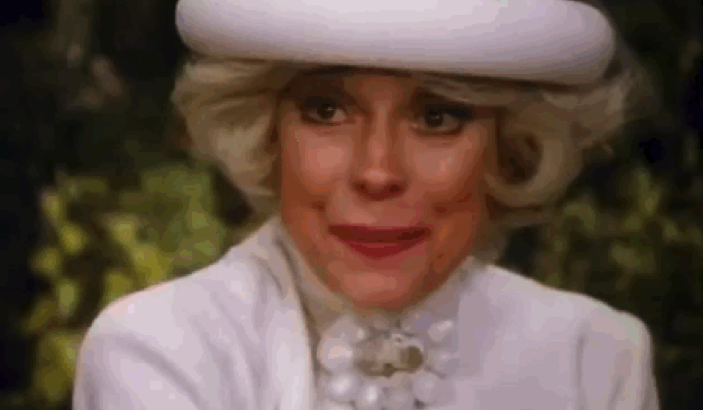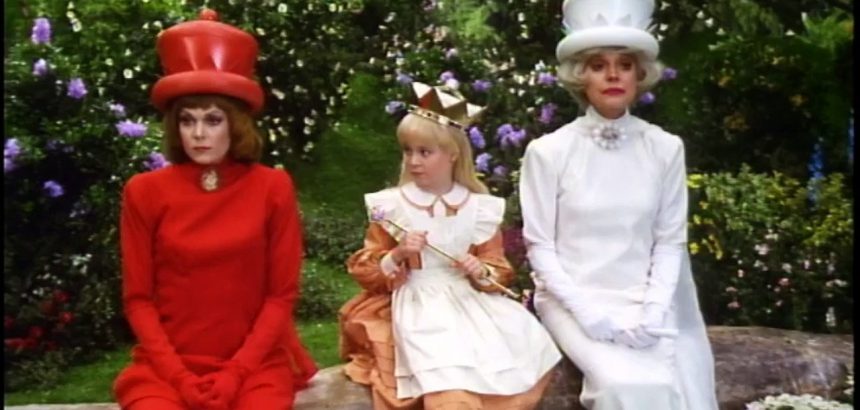Let’s make a canon! And let’s fill it with queer art, or queer-ish art, or art that has no idea how queer it is. Queer art is often secret art: black-market, whispered-about, read-between-the-lines art. And since secret art can be hard to find, let’s shine a light on a few of our favourite things so all our friends can see them.
We’ll call it a canon because it sounds Weighty and Important and Serious, but we also won’t be too serious about it. We won’t make The Canon, just a canon. Each month, we’ll chat with a different queer-about-town and ask them to submit something to the canon. And they’ll tell us what that book or play or movie or TV episode or sculpture or poem or dance piece or opera or photograph or painting or performance art piece or anything else means to them and why they think it deserves a spot in our illustrious canon.
This month, we talked to writer and performer Daniel Krolik about Carol Channing’s most meme-able moment: the 1985 CBS adaptation of Alice in Wonderland.
So, the Alice special is what you’re feeling?
I’ve been holding this in for a very long time!
Let it all out!
It was on in 1985, so I was in the third grade. And it was a time in which if there was a television event or a television special, everyone watched it, because there were only a finite number of channels, and I remember the TV guide for the TV pull-out section for the Montreal Gazette had the front page with a gigantic caricature of all the stars. And I was already very theatrically inclined as a kid, but it was the purest idea of what showbiz was like. And it was almost a fever dream, because it was so big. It was two nights: the first was Alice in Wonderland and the second was Through the Looking Glass.
Oh, that’s such a great idea! What network was it for?
I think it was CBS. Steve Allen wrote the music–who is basically a nightclub composer. He would write for Dean Martin, Jerry Lewis, Ann Margret. I watch it all the time, I watch it once a year—and right away there’s this sorta dissonance between this Lewis Carroll very restrained Victorian material, but then when everybody sings, they sing something like The Velvet Lounge on the Vegas strip. So, like, Sammy Davis Jr plays the Caterpillar, and he raps.
Oh, my god…
And it’s also done in a pre-CGI world, so they had to build these wild sets on these gigantic soundstages; nothing’s computerized. And of course, the cherry on top of this sundae is Carol Channing in the second part as the White Queen, which is one of those things that is this gay identifier that when you see it—like, when I saw it when I was seven—you don’t know why it means so much, and you don’t know why it’s this camp touchstone.
A dog whistle.
Yeah, that’s what it is! A sign from one to another, and at the end of her big number, she transforms into a sheep.

Yeah, and that’s the bit that I’ve seen many times. That’s the meme, right? What does she say when it’s happening?
She says “Beeeetter. Much baaaah-tter.” And it becomes slower and slower and slower. And she then, very clumsily, because it’s 1986 technology, she very clumsily transforms into a live goat. And Alice runs away.
It’s very nightmarish.
It’s extremely nightmarish! Because there is not a person on the planet who has ever talked or behaved like Carol Channing to begin with. So, to put a sheep on top of that is… is really terrifying.
I sometimes find bad or obsolete special effects more unnerving than good ones. I feel like it’s sort of like the vibe when Killer BOB’s face is superimposed on Twin Peaks, where I’m like “ahh, this technology is super lo-fi, and for some reason that makes it even more unsettling!”
It’s like Peter Pan, when you can see the cable attached to the back. When you can see the machinations, that sometimes helps with your suspension of disbelief. And when you see one of these specials today that involves a bunch of celebrities getting together, it’s usually done in this kind of James Franco vein, where there’s a lot of irony and lot of sarcasm, and everybody’s sort of poking fun at a genre. Which for me, makes me sort of stop at the threshold. But Alice is sort of the last gasp of this style of show business without a lot of irony.
Sincerity is very queer. So, you saw this when it aired?
I saw it when it aired. I taped it on VHS. So, when they would let me, I would watch at least a bit of it on a daily basis. I would come home, do my homework, and then watch one chunk of Alice in Wonderland from one commercial break to another. And I had this tape for so long that me and my brother—we anticipated when the commercials would come in. The commercials were almost a part of that special as well, because it’s such a well worn tape. And the great thing about Alice in Wonderland is that it’s sort of an inverse of The Wizard of Oz where she gets to this crazy world and she wants to get home, but everyone’s sort of a dick to her.
Right. She’s not meeting fabulous friends.
“I’ll miss you most of all, Scarecrow!” She’s not getting any of that, and again it’s tied to whatever Victorian political commentary Carroll was making at the time, but because of that, it’s this story about this poor innocent child who meets a bunch of creeps who are awful to her and don’t help her at all.
Related posts

A Queer Art Canon: Lindsey Clark & Alison Bechdel’s Fun Home and Are You My Mother?



